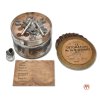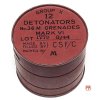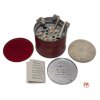I want to simulate a fuse for a Mills 36M detonator and assume a tightly woven cotton rope is what to start with. Do originals look like that or were they coated, meaning smoother with less or no woven structure shown? Anybody have any pictures of WW2 grenade fuses?
Is light yellow a good color?
It is actually an almost white talkum covered fuze. Imagine the Bickford fuze without the tar. Below you will se to different type of detonator boxes with live an original detonators from W.W.II.
Ooh as an extra information you will see why they went from wooden blocks to sheet metal racks in the boxes. :tinysmile_twink_t2:
A quotation from my upcoming book:
SOE Equipment Air Dropped In Europe 1940 - 1945.
In 1942 the detonators for the Mills No.36 grenade packed in
wooden blocks were often found unusable because of deterioration
of the igniters. The igniters could be found with black spots
or corrosion, and the safety fuze with hairy growth, hence all
stocks of igniters manufactured after 30th June 1942 were withhold.
An investigation showed that the deterioration of these
igniters was caused by the fact that the moisture content of the
wooden blocks was higher than allowed by the specification.
Wooden blocks have been found containing nearly 50% moisture,
whilst the maximum allowed by the specification is only
2%. Nothing was wrong with the grenade itself it was merely the
igniters. Maybe this was the reason for the switch to metal racks
(Mk.VI) replacing the wooden blocks.



Instagram account: SOE4045






